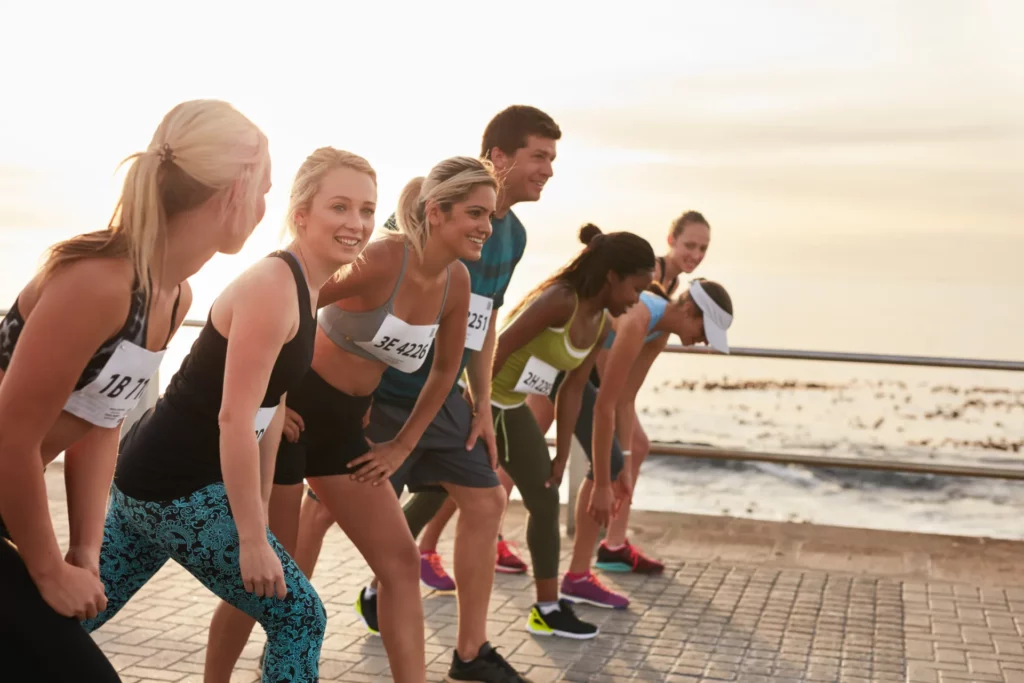Welcome to April! We all hope you had a really great Easter weekend and got some rest in.
The London Marathon starts in a few weeks so it’s a good time to look at the common injuries that can befall runners and how they can be prevented.
The below looks at what the most common culprits are and how our team of elite practitioners can help you.
Runner’s Knee (Patellofemoral Pain Syndrome)
A frequent complaint among runners, runner’s knee manifests as pain around the kneecap, especially when going up or down stairs or after prolonged periods of running. It often stems from overuse, improper biomechanics, or muscular imbalances.
Shin Splints (Medial Tibial Stress Syndrome)
Characterised by pain along the shinbone (tibia), shin splints are typically caused by excessive stress on the shinbone and surrounding tissues. Factors such as over pronation (where your foot rolls inward too much), sudden increases in training intensity, or running on hard surfaces can contribute to this discomfort.
IT Band Syndrome
The iliotibial (IT) band is a thick band of tissue that runs along the outside of the thigh, connecting the hip to the lower leg. IT band syndrome involves inflammation and irritation of this tissue, resulting in sharp or burning pain on the outside of the knee. Tightness in the IT band, improper footwear, asymmetry at your hips, or running on uneven surfaces can exacerbate this condition.
Achilles Tendinitis
The Achilles tendon, located at the back of the ankle, is essential for running propulsion. Overuse, tight calf muscles, or sudden changes in training intensity can lead to inflammation and pain in this tendon, known as Achilles tendinitis. Ignoring early warning signs can increase the risk of a more severe injury, such as a rupture.
Plantar Fasciitis
Plantar fasciitis involves inflammation of the plantar fascia, a thick band of tissue that runs across the bottom of the foot, connecting the heel to the toes. Runners with high arches or flat feet are particularly susceptible to this condition, which presents as stabbing pain in the heel, especially with the first steps in the morning.
Although it seems like there are many injuries that can impact runners, Health in Motion’s specialist team can both treat any of these injuries and support you to prevent these injuries arising. This includes:
Chiropractic
Chiropractic treatment aids runners by improving spinal health, mobility, and alignment, reducing injury risk and enhancing performance through adjustments and guidance on posture and biomechanics.
Osteopathy
Osteopathic treatment focuses on restoring balance and alignment within the body, addressing any imbalances or restrictions that may contribute to injury. Through manual therapy techniques, our osteopaths can alleviate muscular tension, improve joint function, and enhance overall structural integrity, promoting optimal performance and reducing the risk of injury recurrence.
Physiotherapy
Physiotherapy interventions, such as tailored exercise programs, manual therapy, and bio-mechanical assessments, can address specific weaknesses or imbalances that predispose individuals to injury. By addressing underlying movement patterns and functional limitations, our physiotherapists can help optimise performance and reduce injury risk.
Sports Massage
Regular sports massage can aid in muscle recovery, alleviate tension, and improve circulation, helping to prevent overuse injuries and promote faster healing. Targeted massage techniques can also identify areas of tightness or imbalance, allowing for early intervention before they escalate into more significant issues.
With our elite training facilities, our practitioners have access to both the treadmill and various functional training equipment. This enables our practitioners to provide you with specific exercise and movement regimes that support you in your training. This includes:
Running Stride Analysis
Analysing running gait and biomechanics can identify any inefficient movement patterns or imbalances that may predispose runners to injury. By adjusting running form and technique, such as stride length, cadence, and foot strike, individuals can optimise efficiency and reduce stress on vulnerable tissues, lowering the risk of overuse injuries. Any of our practitioners can take this analysis to inform your treatment.
Strength Training
Incorporating strength training exercises that target key muscle groups—such as the quadriceps, hamstrings, glutes, and calves—can help improve overall stability and reduce the risk of overuse injuries. Exercises like squats, lunges, and calf raises can enhance muscle strength and endurance, providing better support for joints during running. Any of our practitioners are able to offer you advice on strength training.
Mobility Improvement
Maintaining optimal joint mobility and flexibility is essential for proper biomechanics, improving performance and injury prevention. Dynamic stretching, functional movement, plyometrics, yoga, and foam rolling can help improve flexibility, reduce muscle tension, and enhance range of motion, decreasing the likelihood of strains and sprains. Any of our practitioners are able to support you maximise your mobility.

